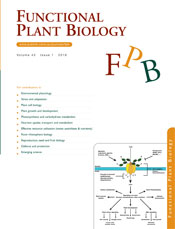
Functional Plant Biology
Volume 43 Number 1 2016
FP15109Signalling via glutamate and GLRs in Arabidopsis thaliana
Distinct proteins that are main actors in neurotransmission in animals exist also in other living organism. Extensive studies in plants revealed an involvement of these so-called glutamate receptors in fundamental signalling events covering the whole plant life cycle. This review presents a comprehensive theory of their role in Arabidopsis thaliana by compiling, condensing and re-evaluating more than 15 years of research.
FP15232Carbon dioxide fertilisation and supressed respiration induce enhanced spring biomass production in a mixed species temperate meadow exposed to moderate carbon dioxide enrichment
Rising atmospheric CO2 concentration ([CO2]) directly affects plants, having consequences for crop yields and water use. The Giessen free air CO2 enrichment facility allows simulation of the response of a mixed species temperate grassland to likely [CO2] levels over the next 20–30 years. Higher [CO2] caused increased spring biomass production due to stimulation of photosynthesis and reduction of respiration in the plant species.
FP15304Physiological trade-offs of stomatal closure under high evaporative gradients in field grown soybean
Breeding crops for water conservation leads to hotter leaves under hot, high-light conditions and thus, the potential for heat-related damage or photoinhibition to the photosynthesis apparatus. However, damaging temperatures were not reached in soybeans under soil water deficits or high air temperature, and no sign of prolonged photosynthetic damage was evident. It appears that for the broad range of conditions measured in this study, water conservation did not have negative consequences on photosynthetic capacity.
FP15149Differential growth of Spartina densiflora populations under saline flooding is related to adventitious root formation and innate root ion regulation
Long-lasting floods in lowland areas of salt marshes are expected as a consequence of global warming. We assessed the ability of Spartina densiflora plants collected from lowlands and uplands along a subtle topographic gradient of a salt marsh to deal with saline flooding. A better performance in favour of lowland plants in adventitious rooting and root ion regulation indicated the presence of locally adapted populations.
FP15216Root biomass in the upper layer of the soil profile is related to the stomatal response of wheat as the soil dries
Terminal drought is the most detrimental abiotic stress affecting wheat grain yield in Mediterranean-type environments. When terminal drought was initiated by withholding water from the top segment of a split pot, wheat genotype with more root density distributed in the drying upper soil layer initiated stomatal closure earlier than the other. The results highlight the importance of stomatal regulation and root efficiency to extract water from deeper soil profile to reduce yield gap under terminal drought.
FP15312Rutin, a flavonoid with antioxidant activity, improves plant salinity tolerance by regulating K+ retention and Na+ exclusion from leaf mesophyll in quinoa and broad beans
In this work we used halophyte species Chenopodium quinoa to investigate the causal relationship between salinity and oxidative stress tolerance in plants. The most dramatic changes observed were in rutin, a flavonoid with non-enzymatic antioxidant activity. Exogenous application of rutin to glycophyte bean leaves improved tissue tolerance by mitigating reactive oxygen species-induced K+ efflux from the cell.



